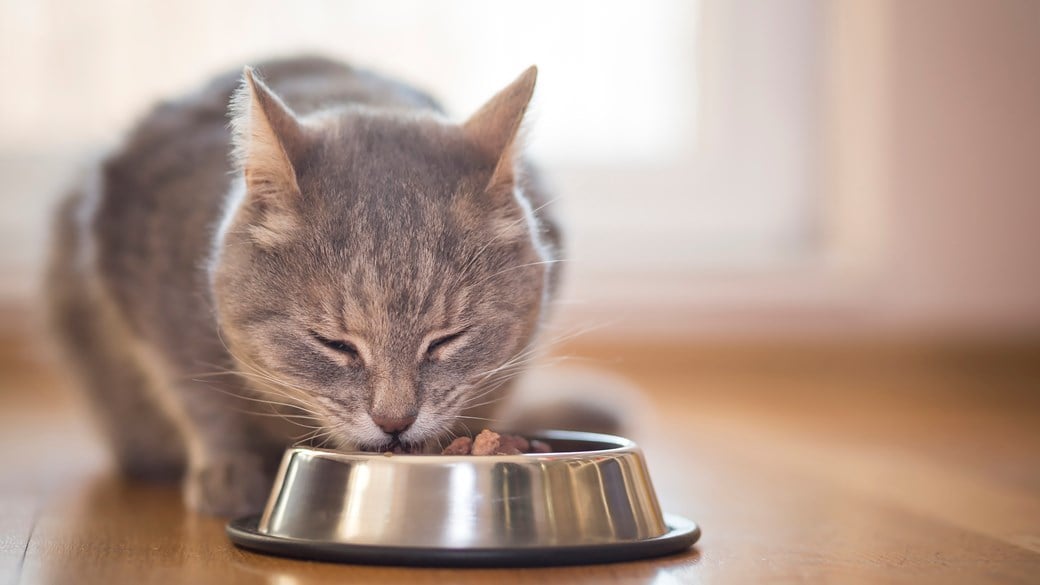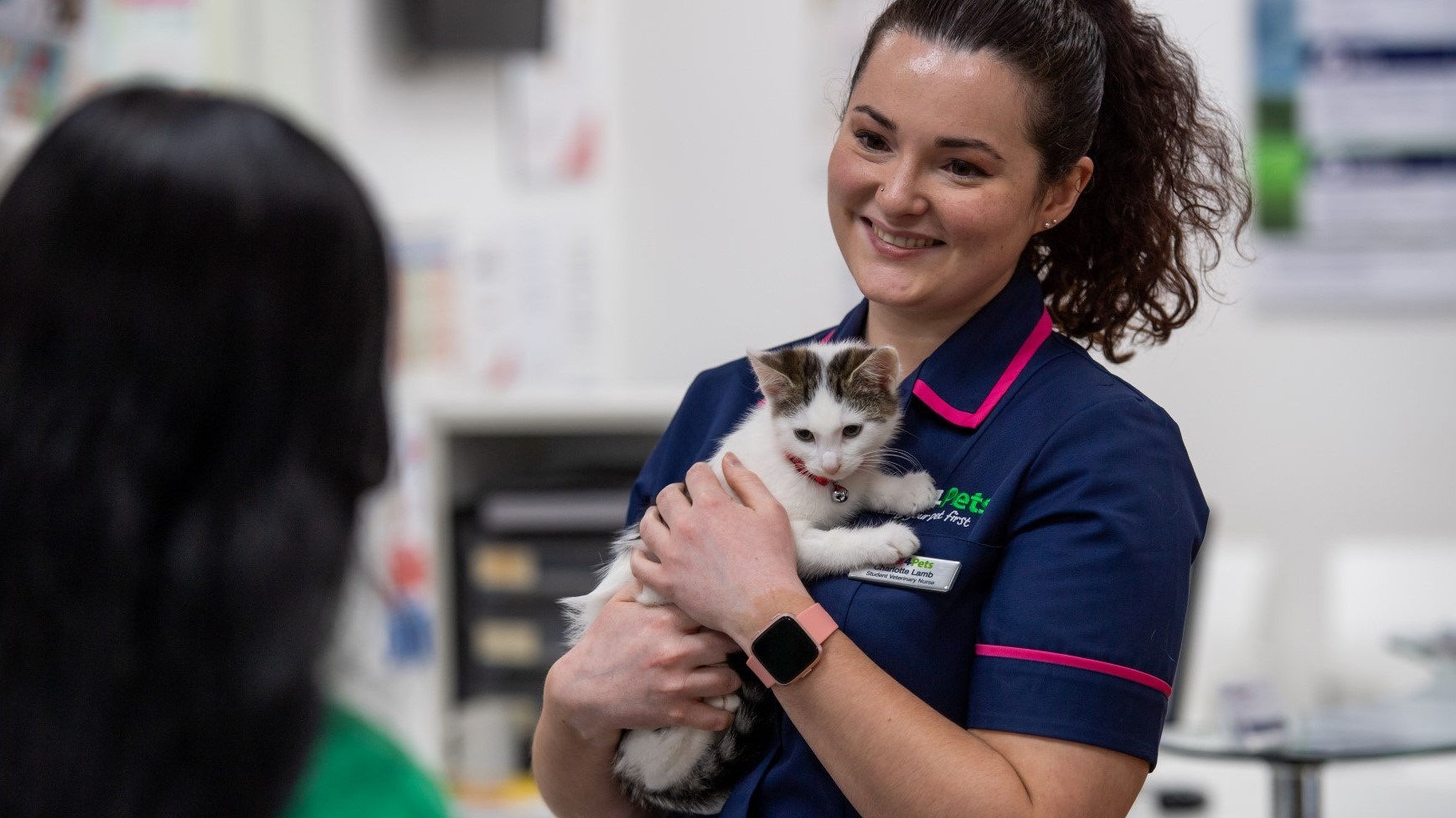
A Guide To Feeding Your Cat
The nutrition you provide your cat is fuel for everything they do – including growth, development, skin and coat condition and exercise.
Choosing a food suitable for your cat is one of the first decisions you will have to make. Unsurprisingly, as your cat ages, their needs will alter– nutritional needs are not fixed and change with your cat. Making sure you are always feeding food that is right for your cat is an important part of supporting their health, and this may mean changing their diet several times throughout their life. The nutrition demands of your cat are affected by:
- Exercise levels
- Weight
- Life stage
- State of health
- Neutering status
With many cat foods looking similar and so many to choose from, the selection process can feel overwhelming. Thankfully, your vet can help you choose, and will also help you decide when and if to change your cat's diet in the future.
More cat diet advice
Go to any pet shop or browse the internet and you will be faced with hundreds of potential foods to feed your cat, as well as hosts of opinions on the choices you should make. With many cat foods looking similar and so many to choose from, the selection process can feel overwhelming.
Thankfully, your vet can help you choose, and will also help you decide when and if to change your cat’s food in the future.
The first consideration must be your cat’s nutritional needs.
Once you are comfortable with the nutritional needs of your cat, you may find the suitable available foods come in a choice of wet or dry preparations. Both will contain the same nutritional value, so what are the advantages and disadvantages of wet versus dry?
There are pros and cons to both wet and dry food, and you should choose which you feel is most suitable for you. If you aren’t sure, your vet can help you choose. Some owners also choose to mix wet and dry, or use wet food as a ‘treat’.
Pros:
- Wet food, by definition, contains water. This means it can be a good source of extra hydration in animals that are reluctant to drink themselves, and the soft texture can be easier to eat for animals with any mouth pain, or difficulty eating due to conformation or dental issues.
- Wet food also tends to smell stronger, which can make it more appealing to unwell animals. Like us, being ill can affect sense of smell and appetite, so stronger smelling foods may be more suitable for animals who need tempting to eat.
Cons:
- Wet food, being stronger smelling, can be more unpleasant in the house and make more mess. It also lasts much less time than dry food, so comes in smaller packages. This can make wet food far less economical than dry food.
- Wet food also sticks around in the mouth, and animals fed a purely wet diet often have poorer dental health than animals on dry food.
Pros:
- Dry food is very economical, and can be very handy to leave out for cats that eat slowly as it will not spoil over a day. It is clean, and although harder than wet food, kibble from breed-size specific foods will be small or large enough to be appropriate for your cat’s mouth.
- Dry food is generally better for dental health, can be used as treats, and stores well. If you like the idea of dry but are worried about water, many dry foods can have a little water added on top.
Cons:
- Dry food does not contain as much moisture as wet food, which is especially important in older or unwell animals, or in hot weather.
- Dry food does not smell, which can make it unappealing to some pets. Dry food often also contains slightly less animal protein, however quality of protein rather than quantity should be a higher consideration.
How much you will need to feed will depend on the nutritional requirements of your cat, as well as the quality of food. High-quality commercial diets tend to have more nutritional value, and hence you may need to feed less per day. This is especially important for cats that may struggle to get enough nutrition, such as growing kittens, and high activity or elderly cats, and also means the cost per day of premium foods is often less than you might expect.
To help guide you, high-quality cat foods will state a suggested daily amount to feed your cat per day. This is a useful start point but is not suitable for every animal –just like us, cats have different metabolisms and nutrition is not ‘one size fits all’. With this in mind, monitoring your cat’s condition is the best way to moderate how much you feed your cat, making sure you are always giving enough to keep your cat’s weight stable at their optimum size. The packet guidelines, however, can give you a helpful start point.
Just like us, weight alone is not an appropriate measure of how healthy a cat’s diet is. Making sure your cat is a healthy size can be done using body condition scoring.
Irrespective of the type of diet and type of cat, weighing the food you give should always be part of the daily routine. This is much more accurate than feeding by eye, keeps the diet stable, and means that diet can be adjusted more easily.
Young kittens have very small stomachs and are best started on 4 small meals a day – if that’s not possible, leave out some dry food so they can nibble.
At 4 months old, this can be dropped to 3 meals daily.
At 6 months old, this can be dropped to 2 meals daily. Cats need to be fed at least twice daily, as they are adapted to eat little and often.
Cats prefer to have their water bowl and food bowl separate, and both should be well away from any litter trays.
Cats like to be able to see their surroundings when they eat to feel safe, so putting their food in the corner of the room can be stressful for them.
Feeding in a quiet area, where they can see the room and feed at the same time, will help keep mealtimes relaxed. Using a clean bowl, and making sure to wipe up any spillages, will keep your cat happy as they can be very fastidious.
If you have multiple cats, feeding some distance apart can reduce conflict. For cats that really don’t get along, feeding them in separate rooms may be necessary to keep the peace.
If you need to change your cat’s diet, this should be done slowly. Sudden changes in feeding routine can upset your cat’s stomach, and may cause your cat to go off the new food.
Moving from one food to another should be done over at least a week, with a very small amount of the new diet replacing the old in the first bowl, and increasing amounts of the new food over the transition period.
Treats or human foods should only be up to 10% of your cat’s daily calories. Overfeeding treats and human food can lead to obesity, which has a huge range of associated health problems. Giving too many treats will also alter the balance of nutrition that your cat is receiving, as the vast majority of commercially available diets are formulated to be a complete food and provide everything that your cat needs.
Care should also be taken with treat foods like tuna – these should only be used sparingly, as they are not complete and can cause problems when fed as the bulk of a diet. The strong smell and taste can make tuna quite addictive to cats, so it is important to be firm – just like children, cat’s often do not know what is best for them!
Despite popular misconception, cats actually struggle to digest the lactose in milk and it can cause them to have upset tummies.
Water is all your cat actually needs to drink, and this should be provided fresh and always be available. If you do want to give your cat something a little extra as a treat, ‘cat milk’ can be purchased, which is formulated especially for cats. This contains low lactose, so won’t upset your cat’s tummy, but it does contain calories and should only be given in moderation.
Outdoor cats are highly independent, and it is not uncommon for cats to visit several homes. This can lead to difficulties if a cat is being fed at several locations – especially if your cat is putting on weight, or has a health condition which is nutritionally managed. Collars can be purchased that say ‘Do Not Feed’ or similar, to dissuade others from feeding your cat. Some owners have even resorted to posting flyers through all neighbouring doors!
As nutritional intake affects all parts of your cat, and processing and distributing nutrition is a procedure touched by many body systems, using nutrition to affect health is a clear step to supporting health care.
Therapeutic diets can be used in a wide range of conditions including:
- Kidney disease
- Liver disease
- Heart disease
- Digestive support
- Food sensitivity
- Urinary health
- Joint support
- Diabetes
- Post-operative recovery
- Skin support
Health Plans to keep your cat healthy
At Vets4Pets we offer a range of Health Plans that make essential routine treatments more affordable. You'll save money on things like annual vaccinations, flea and worm treatment and routine health check-ups.

Cat Advice
Read more of our expert cat advice to keep your cat happy and healthy.
